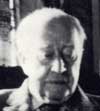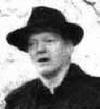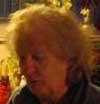Who = Who, protagonists of the Merzbarn story
 Kurt Schwitters,
a famous German Dada-artist, lived as a refugee from the Hitler regime in England.
Kurt Schwitters,
a famous German Dada-artist, lived as a refugee from the Hitler regime in England.
 Edith Thomas,
also known as Wantee, was the most important person in the last years of Kurt Schwitters’ life. They met in London
in 1944 and moved a year later to Ambleside where they spent the rest of their lives.
Edith Thomas,
also known as Wantee, was the most important person in the last years of Kurt Schwitters’ life. They met in London
in 1944 and moved a year later to Ambleside where they spent the rest of their lives.
 Harry Pierce,
friend and admirer of Kurt Schwitters. He offered Schwitters the use of the barn on Cylinders Estate. Harry
was a professional landscape architect who turned his estate into a beautiful landscaped park in the nineteen-forties and
-fifties. Pierce made many attemps to save the wall and the barn.
Harry Pierce,
friend and admirer of Kurt Schwitters. He offered Schwitters the use of the barn on Cylinders Estate. Harry
was a professional landscape architect who turned his estate into a beautiful landscaped park in the nineteen-forties and
-fifties. Pierce made many attemps to save the wall and the barn.
 Fred
Brookes, Richard Hamilton scholar and eyewitness of the journey, supervised the removal and the journey of the wall and
undertook its restoration. In 1965 he was a 22 year old art student at the university of Newcastle. He wrote the report of the
journey of the wall.
Fred
Brookes, Richard Hamilton scholar and eyewitness of the journey, supervised the removal and the journey of the wall and
undertook its restoration. In 1965 he was a 22 year old art student at the university of Newcastle. He wrote the report of the
journey of the wall.
 Mary Burkett,
Schwitters’ scholar and eyewitness of the journey. She followed the low loader by car, the first part of the journey.
She also knew Edith Thomas later in live. She wrote the booklet ‘Kurt Schwitters, Creator of Merz’.
Mary Burkett,
Schwitters’ scholar and eyewitness of the journey. She followed the low loader by car, the first part of the journey.
She also knew Edith Thomas later in live. She wrote the booklet ‘Kurt Schwitters, Creator of Merz’.
 Richard
Hamilton, renowned artist, was Master of painting and Head of the Foundation Course at the University of Newcastle
in 1965. Richard led the initiative to move the Merzbarn, in close cooperation with Kenneth
Rowntree, who was at that time Professor of Fine Art (equivalent to Head of Department), who actually made the
decision to accept Mr Pierce’s offer and persuaded the University to raise the money.
Richard
Hamilton, renowned artist, was Master of painting and Head of the Foundation Course at the University of Newcastle
in 1965. Richard led the initiative to move the Merzbarn, in close cooperation with Kenneth
Rowntree, who was at that time Professor of Fine Art (equivalent to Head of Department), who actually made the
decision to accept Mr Pierce’s offer and persuaded the University to raise the money.
 Ian Hunter
and Celia Larner, of ‘Littoral’, a non-profit art trust, which owns the Merzbarn in Elterwater today.
Ian Hunter
and Celia Larner, of ‘Littoral’, a non-profit art trust, which owns the Merzbarn in Elterwater today.
 Robin
Martakies, lives in Ambleside and is author of the book ‘Free Spirit’ about Kurt Schwitters.
Robin
Martakies, lives in Ambleside and is author of the book ‘Free Spirit’ about Kurt Schwitters.
Active as a Media and
Public Affairs Officer for Windermere Lake Cruises Ltd.